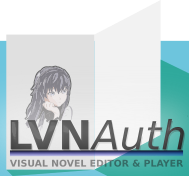

LVNAuth Tutorials - What is LVNAuth?
LVNAuth is a desktop application for Linux that lets you create visual novels.
A visual novel is a story that includes images, audio, and dialogue text - similar to what you would find in a role-playing game.
A visual novel can have dialogue text that the viewer reads, or it can contain voices for on-screen characters, or both.
LVNAuth does not come with any images (sprites), audio, characters, or even any fonts. It's all up to the creator of the visual novel to provide them. LVNAuth is a tool that combines multimedia elements, such as images, audio and dialogue text, into a visual novel that viewers can watch and interact with.
LVNAuth compiles visual novels into a single file with the file extension: .lvna
This file will contain all the sprites (images), audio, dialogue text, and scripts for your visual novel. However, the file won't include LVNAuth itself; your viewers will need LVNAuth to play your visual novel's .lvna file.
A note about .lvna files:
The resources of your visual novel get compiled into one file (which can include images, audio, dialogue text, font sprite sheets, scripts). However, the data in the file is not encrypted. This means that the data inside the .lvna file can technically be retrieved if someone really wanted to - just keep that in mind. If you need protection, privacy, encryption or any kind of security for your visual novels, LVNAuth and .lvna files don't provide that.
Aside from creating visual novels with stories (which is the main intention of LVNAuth), there are some other uses, such as:
Creating character cutscenes for a game you're working on. Lets say you have a strategy game and you want to show characters talking to each other between levels. You could have your game show an LVNAuth window in a new process with your characters speaking and once the LVNAuth process/window closes, your game can resume.
Character/Mascott assistant for your applications. Let's say you've developed a desktop program and you want to create a multimedia-rich help system for it. You could technically use LVNAuth to greet your users with a character when your app first starts up or you could ask your users questions about what they're trying to do with your application and then have a character explain relavant information based on the user's choices. This type of use-case is not yet available but is planned.
Last updated: Thu 30 October 2025